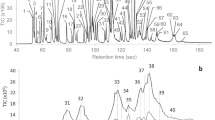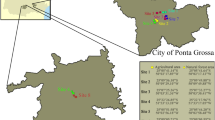Abstract
The chemicals warfare agents (CWAs) are an extremely toxic class of molecules widely produced in many industrialized countries for decades, these compounds frequently contained arsenic. The plants where the CWAs have been produced or the plants where they have been demilitarized after the Second World War with unacceptable techniques can represent a serious environmental problem. CWAs standards are difficult to find on market so in present work an environmental assessment method based on markers has been proposed. Triphenylarsine, phenylarsine oxide and thiodiglycol have been selected as markers. Three reliable analytical methods based on gaschromatography and mass detection have been proposed and tested for quantitative analysis of markers. Methods performance have been evaluated testing uncertainty, linearity, recovery and detection limits and also comparing detection limits with exposure limits of reference CWAs. Proposed assessment methods have been applied to a case study of a former industrial plant sited in an area characterized by a high background of mineral arsenic.



Similar content being viewed by others
References
Alcaro L, Torre CD, Petochi T, Sammarini V, Matiddi M, Corsi I, Baroni D, Giordano P, Marino G, Focardi S, Amato E (2012) Studies on environmental effects of underwater chemical munitions in the southern adriatic sea (Mediterranean Sea). Mar Technol Soc J 46:10–20. doi:10.4031/MTSJ.46.3.5
Baba KT, Maejima Y, Watanabe E, Eun H, Ishizaka M (2008) Arsenic speciation in rice and soil containing related compounds of chemical warfare agents. Anal Chem 80:5768–5775. doi:10.1021/ac8002984
Beretta GP, Pellegrini R (2004) Linee Guida per il collaudo di scavi per interventi di bonifica on-site e off-site Linee guida n.9 Provincia di Milano http://www.cittametropolitana.mi.it/export/export_14032014/p_bonifiche_lg_9.pdf
Black RM, Muir B (2003) Derivatisation reactions in the chromatographic analysis of chemical warfare agents and their degradation products. J Chromatogr A 1000:253–281
Black RM, Clarke RJ, Read RW, Reid MTJ (1994) Application of gas chromatography-mass spectrometry and gas chromatography-tandem mass spectrometry to the analysis of chemical warfare samples, found to contain residues of the nerve agent sarin, sulphur mustard and their degradation products. J Chromatogr A 662(2):301–321
Capozzi N, D’Amico F, Malara F (2009) la distruzione delle vecchie armi chimiche italiane. Rivista Italiana Difesa, pp 56–61
Carrick W, Beck N, Cooper D, Muir B (2001) Extraction of thiodiglycol from soil using pressurized liquid extraction. J Chromatogr A 907:221–227
Coli M, Principi G, Peccerillo A (1991) Evoluzione geodinamica recente dell’Appennino settentrionale e attività magmatica tosco–laziale: vincoli e problemi [Recent geodynamic evolution of the northern Apennines and Tuscany-Latium magmatic activities: constraints and problems. Studi Geol Camerti 1:403–413
D’Aprile L, Moretto C (2006) Sito di Interesse Nazionale di Porto Marghera—Proposta di integrazione del “Protocollo Operativo” per il campionamento e l’analisi dei siti contaminati—Fondo scavo e Pareti—APAT. http://www.isprambiente.gov.it/files/temi/proposta-modifica-protocollo-operativo-rev07-nov06.pdf
Daus B, Mattusch J, Wennrich R, Weiss H (2008) Analytical investigations of phenyl arsenicals in groundwater. Talanta 75:376–379. doi:10.1016/j.talanta.2007.11.024
Daus B, Hempel M, Wennrich R, Weiss H (2010) Concentration and speciation of arsenic in groundwater polluted by warfare agents. Environ Pollut 158:3439–3444. doi:10.1016/j.envpol.2010.06.029
Dubey DK, Pardasani D, Palit M, Gupta AK, Kanaujia PK (2004) Gas chromatography-mass spectrometry analysis of trifluoroacetyl derivatives of precursors of nitrogen and sulfur mustards for verification of chemical weapons convention. J Chromatogr A 1059:157–164
Dubey DK, Pardasani D, Palit M, Gupta AK, Jain R (2005) On-matrix derivatisation–extraction of precursors of nitrogen- and sulfur-mustards for verification of chemical weapons convention. J Chromatogr A 1076:27–33
Greene J (2013) Sittig’s handbook of pesticide and agricultural chemicals William Andrew Norwich, NY
Haas R (1998) Determination of chemical warfare agents. Environ Sci Pollut Res 5(2):63–64. doi:10.1007/BF02986387
Haas R, Krippendorf A (1997) Determination of chemical warfare agents in soil and material samples. Environ Sci Pollut Res 4(3):123–124. doi:10.1007/BF02986314
Haas R, Schmidt TC (1996) Analysis of byproducts of sulfur mustard. Oekotox 8: 241–242. http://www.r-haas.de/f19.html
Haas R, Schmidt TC, Steinbach K, von Löw E (1998) Chromatographic determination of phenylarsenic compounds. Fresenius J Anal Chem 361:313–318. doi:10.1007/s002160050892
Hanaoka S, Nagasawa E, Nomura K, Yamazawa M, Ishizaki M (2005) Determination of diphenylarsenic compounds related to abandoned chemical warfare agents in environmental samples. Appl Organomet Chem 19:265–275. doi:10.1002/aoc.790
Hazardous Substances Data Bank in TOXNET http://toxnet.nlm.nih.gov/cgi-bin/sis/htmlgen?HSDB Accessed 06 May 2014
Henriksson J, Johanisson A, Bergqvist PA, Norrgren L (1996) The toxicity of organoarsenic based warfare agents: in vitro and in vivo studies. Arch Environ Contam Toxicol 30:213–219. doi:10.1007/BF00215800
International Agency for Research on Cancer (2012) Group 1 Monograph 9 Supplement 7, pp 259–260 http://monographs.iarc.fr/ENG/Monographs/vol100F/mono100F-30.pdf
Ishizachi M, Yanaoka T, Nakamura M, Hakuta T, Ueno S, Komuro M, Shibata M, Kitamura T, Honda A, Doy M, Ishii K, Tamaoka A, Ahimojo N, Ogata T, Nagasawa E, Hanaoka S (2005) Detection of bis(diphenylarsine)oxide, diphenylarsinic acid and phenylarsonic acid, compound probably derives from chemical warfare agents in drinking well water. J Health Sci 51(2):130–137
Killelea DR, Aldstadt JH (2002) Identification of dimethylchloroarsine near a former herbicide factory by headspace solid-phase microextraction gas chromatography-mass spectrometry. Chemosphere 48(9):1003–1008
Leermakers M, Baeyens M, De Gieter M, Smedts B, Meert C, De Bisschop HC, Morabito R, Quevauviller Ph (2006) Toxic arsenic compounds in environmental samples: speciation and validation. Trends Anal Chem 25(1):1–10. doi:10.1016/j.trac.2005.06.004
Li H, Muir R, McFarlane NR, Soilleux RJ, Yu X, Thompson IP, Jackman SA (2013) Soil biotransformation of thiodiglycol, the hydrolysis product of mustard gas: understanding the factors governing remediation of mustard gas contaminated soil. Biodegradation 24(1):125–135
Mangalgiri KP, Adak A, Blaney L (2015) Organoarsenicals in poultry litter: detection, fate, and toxicity. Environ Int 75:68–80
Medvedeva N, Polyak Y, Kuzikova I, Orlova O, Zharikov G (2008) The effect of mustard gas on the biological activity of soil. Environ Res 106(3):289–295
Ng J, Gomez-Caminero A, Howe P, Hughes M, Kenyon E, Lewis DR, Moore M, Aitio G. Becking A (2001) Environmental Health Criteria 224 ARSENIC AND ARSENIC COMPOUNDS http://apps.who.int/iris/bitstream/10665/42366/1/WHO_EHC_224.pdf
Perini G, Conticelli S, Francalanci L, Davidson JP (2000) The relationship between potassic and calc-alkaline post-orogenic magmatism at Vico volcano, central Italy. J Volcanol Geoth Res 95(1):247–272
Pitten FA, Thurow K, Koch A, Kramer A (2000) Chemical analysis of organoarsenic based chemical warfare agents in the environment. In: Markerf M, Friese K (eds) Trace elements their distribution and effect on environment. Elsevier Science, Amsterdam, pp 215–242
Pragney D, Vijaya Saradhi UVR (2012) Sample preparation techniques for the analysis of chemical warfare agents and related degradation products. Trend Anal Chem 37:73–81
Sartori M (1939) The war gases: chemistry and analysis D. Van Nostrand CO., inc, New York
Smith PA, Kimm GL, Hook GL (2002) Application of headspace solid-phase microextraction and gas chromatography–mass spectrometry for detection of the chemical warfare agent bis(2-chloroethyl) sulfide in soil. J Chromatogr A 971:185–191
Szostek B, Aldstadt J (1998) Determination of organoarsenicals in the environment by solid phase microextraction-gas chromatography-mass spectrometry. J Chromatogr A 807:253–263. doi:10.1016/S0021-9673(98)00080-6
Tornes JA, Opstad AM, Johnsen BA (2006) Determination of organoarsenic warfare agents in sediment samples from Skagerrak by gas chromatography-mass spectrometry. Sci Total Environ 356:235–246. doi:10.1016/j.scitotenv.2005.03.031
USACHPPM/ORNL Technical report (1999) health-based environmental screening levels for chemical warfare agents, March 99
Wagner GW, MacIver BK (1998) Degradation and fate of mustard in soil as determined by 13C MAS NMR. Langmuir 14(24):6930–6934
Acknowledgments
The acknowledgments for the realization of this work go to Technical Director of Regional Agency for Environmental Protection of Lazio Ing. Rossella Cintoli.
Author information
Authors and Affiliations
Corresponding author
Rights and permissions
About this article
Cite this article
Sassolini, A., Brinchi, G., Di Gennaro, A. et al. Evaluation of Molecular Markers and Analytical Methods Documenting the Occurrence of Mustard Gas and Arsenical Warfare Agents in Soil. Bull Environ Contam Toxicol 97, 432–438 (2016). https://doi.org/10.1007/s00128-016-1860-1
Received:
Accepted:
Published:
Issue Date:
DOI: https://doi.org/10.1007/s00128-016-1860-1




